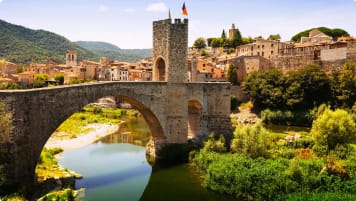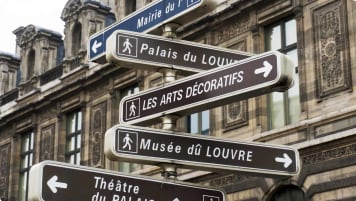Morocco tour for senior travellers
Embark on an unforgettable journey through Morocco: A Gateway to a world of vibrant colors, cultural diversity, and endless wonder. Join our escorted small group tour designed for senior travellers, whether you're a couple or a solo adventurer, and immerse yourself in the captivating allure of Casablanca, Fez, Meknes, Rabat, Marrakech and beyond. Experience the richness of Moroccan traditions and heritage as we explore this enchanting destination.
From €7,783EUR
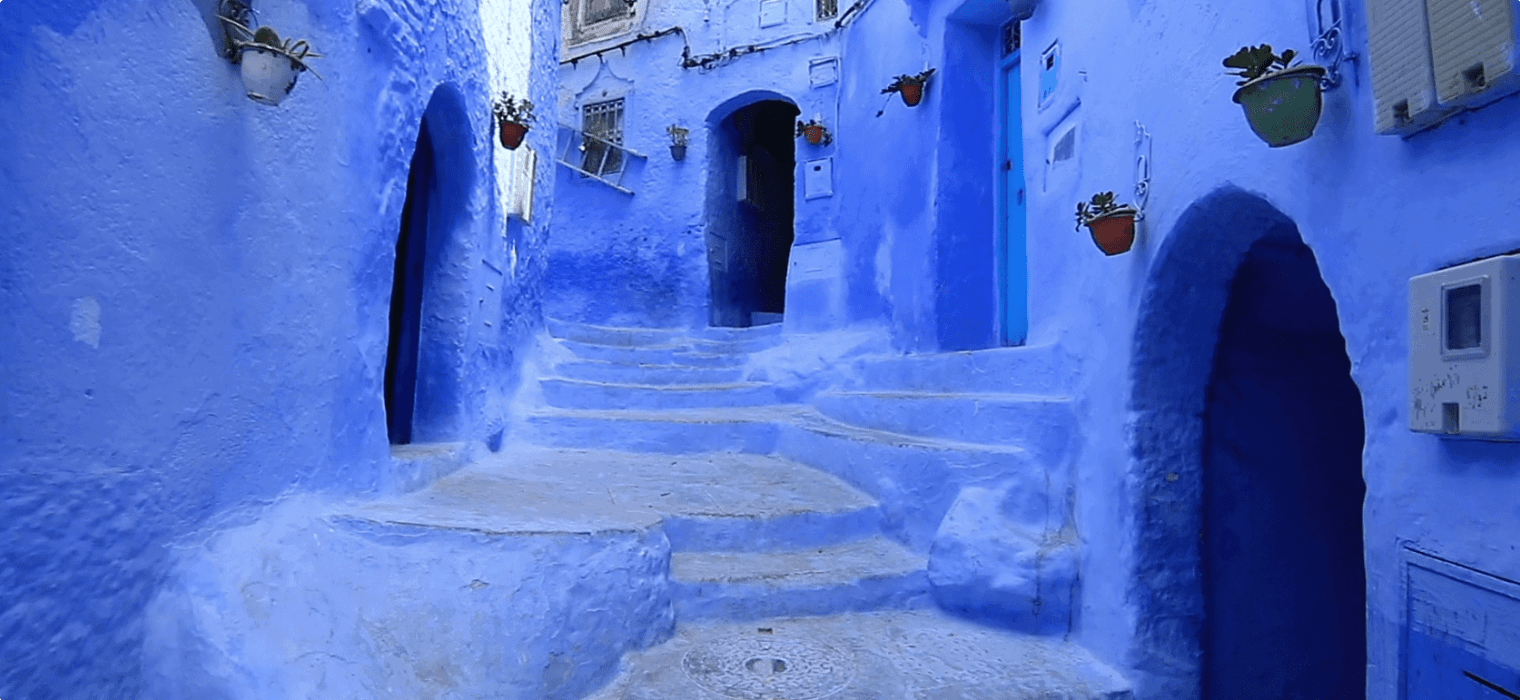
Highlights
- 1. Learn about traditional crafts, like leather-making, ceramics, and Argan oil extraction
- 2. Step back in time as we explore historic Fez
- 3. Marvel at Moorish architecture on this Morocco Tour
- 4. Visit Ksar of Ait-Ben-Haddou, the historic sub-Saharan settlement that has a place in Hollywood
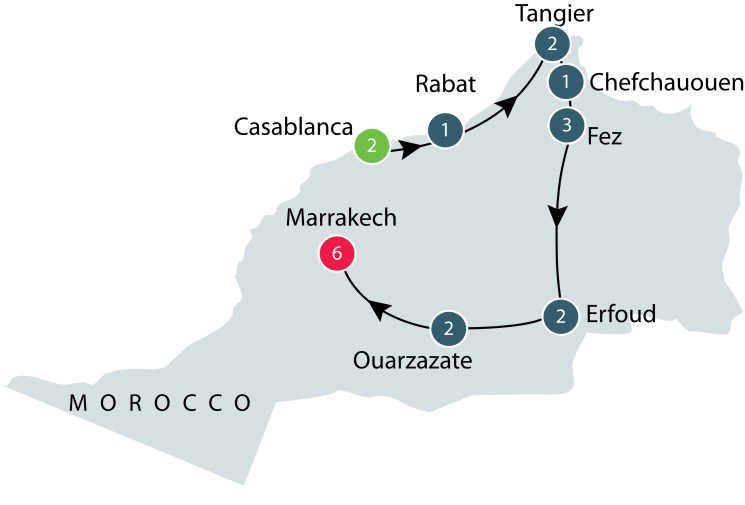
Departure Dates
| Departure Date | Price |
|---|---|
| 06 October 2025 Ends 25 October 2025 • 20 days €7,783 Twin €9,938 Single Available | Selected |
| 02 March 2026 Ends 21 March 2026 • 20 days €8,088 €7,600 Twin €10,121 €9,633 Single Save up to $800Early Bird | |
| 01 April 2026 Ends 20 April 2026 • 20 days €8,088 Twin €10,121 Single Available | |
| 05 October 2026 Ends 24 October 2026 • 20 days €8,088 Twin €10,121 Single Available | |
| 01 March 2027 Ends 20 March 2027 • 20 days €8,272 Twin €10,304 Single Available | |
| 31 March 2027 Ends 19 April 2027 • 20 days €8,272 Twin €10,304 Single Available | |
| 04 October 2027 Ends 23 October 2027 • 20 days €8,272 Twin €10,304 Single Available |
Morocco Small Group Tour: an exotic gateway to Africa
The North African Kingdom of Morocco is at the intersection of Europe and Africa, a gateway to two millennia of history. Step through and discover a world of colour, diversity and wonder, unlike anything you have experienced before. Rich traditions and heritage are very much alive here, but there is a paradoxical youthfulness to the culture, and a warmth that will draw you in. Wander through the narrow, bustling streets of medinas in cities like Marrakech, Fes, and Chefchaouen. These historic marketplaces offer a sensory feast of colors, aromas, and traditional crafts. Get lost in the myriad cobbled alleyways of UNESCO World Heritage Site Marrakech, known for its iconic Jemaa el-Fnaa square, the historic Bahia Palace, and the serene Majorelle Garden. We drive through the scenic Atlas Mountains, where picturesque Berber villages and stunning valleys await. From Marrakech, we will do a day trip to the charming coastal town of Essaouira, known for its historic medina, vibrant arts scene, and scenic beaches. The city's fortified walls offer panoramic views of the Atlantic Ocean.
This tour in Morocco offers something for everybody, from adventurous nature walks and bustling marketplaces, to the pristine silence of the Sahara, enjoyed over traditional mint tea. Keep an open mind and heart, and you will be rewarded by unique travel experiences that will take your breath away.
Fez and the Oldest University and Library in the World
Highlights of this guided tour for mature and senior travellers include excursions to the historic city of Fez, Morocco's cultural and spiritual centre. Fez is the oldest of the four imperial cities in Morocco–namely, Fez, Marrakech, Meknes, and Rabat– and is located in the northern part of the country on the banks of the Wadi Fez.
Fez became the home of the oldest continuously operating university in the world, the University of Al-Karaouine (also spelled al-Qarawiyyin), founded in 859 by Fatima al-Fihri. Little is known of Al-Fihri’s early life, but in the early 9th century, she migrated with her family from Qayrawan in Tunisia to Fez, Morocco. She inherited a large fortune after her father’s death, and used her inheritance to commission a mosque and madrasa (Islamic religious school) in order to give back to her adopted homeland. This complex eventually grew into a university, named after her birthplace.
The oldest university in the world was incorporated into the state education system in 1947 and began to be modernised. After a long hiatus, the monarchy restored traditional Islamic education at the university in 1988. Education at the University of Al-Karaouine (or al-Qarawiyyin) now concentrates on Islamic religious and legal sciences, with a few lessons on non-Islamic subjects, such as French and English. It was not open to the public, and in 2012, when Morocco’s Ministry of Culture requested for an assessment of the establishment’s structural integrity, the assessor, Canadian-Moroccan architect Aziza Chaouni, was shocked to discover the poor state of the old mosque and madrasa. The government began taking steps to restore the library and to preserve the rare manuscripts housed within (which includes a 9th-century Quran and the oldest known accounts of the life of the prophet Muhammad) and finally opened it to the public in 2016.
More Highlights: Cities Across the Sahara and On the Atlantic
We visit the UNESCO World Heritage listed city of Rabat. We explore Tangier, located just about 13 kilometres from Spain across the Straits of Gibraltar, where the Atlantic Ocean and the Mediterranean meet. This is Europe’s gateway to Africa. Over the centuries, Tangier has been a haven for artists and writers drawn to its hotbed of culture and its spectacular views of the sea.
We board 4×4 vehicles and weave our way through various nomadic villages of the Sahara, and traverse the stunning fine sands of Merzouga. Staying in a hotel in Ouarzazate, we make a day trip to spectacular Ksar of Ait-Ben-Haddou, an impressive feat of Moroccan architecture which you may recognise from such films as Lawrence of Arabia and Gladiator. There's Meknes, an important heritage site touted to be the Moroccan Versailles, the vibrancy of Djemma El Fna place in Marrakesh, and Chefchaouen, the famous 'blue town' in the Rif Mountains. We see the Roman ruins of Volubilis.
On this tour of Morocco, when we travel from one city to the next, we watch as the deserts give way to lush oases, or as mountains strike up before the red dunes. On our journey, we learn about traditional processes, such as leather-making and the extraction of prized Argan oil, understand the role of Persian carpets in living and the symbolism of Mosques. We meet people from Saharan nomads to charming street performers. The colours and patterns of the Moroccan landscape are matched only by the vibrant palettes of its' traditional crafts and wares. The same culture infuses the delicious local cuisine - which we sample by eating breakfast, lunch and dinner at a local restaurant.
Our trip will be accompanied by an Odyssey Program Leader and ushered along by a tour guide or local guide in each wondrous destination.
Tour Notes
Itineraries may change if flight schedules, site availability, and other inclusions have to be amended prior to departure.
Articles about Morocco published by Odyssey Traveller:
- Discover Morocco: Continental Crossroads
- The Literary Allure of Tangier, a City of Storytellers
- Marrakech
- Chefchaouen
- A Library in Morocco, the worlds oldest.
- Volubilis built by the Romans
- Ksar of Ait Ben Haddou
- Meknes
- Cave of Hercules
- Fez
For all the articles Odyssey Traveller has published for mature aged and senior travellers, click through on this link.
External articles to assist you on your visit to Morocco:
Gallery
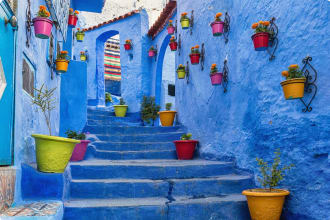
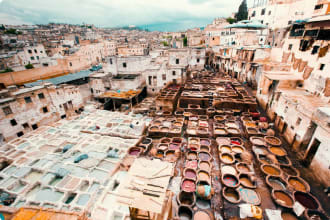
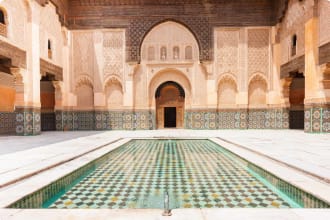
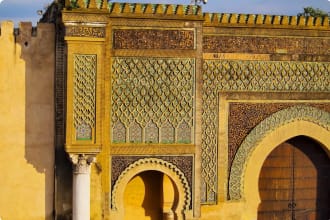
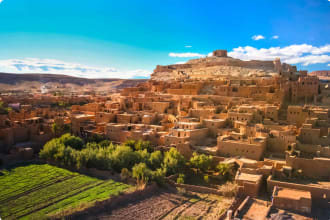
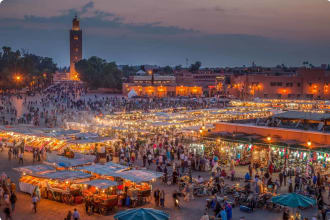
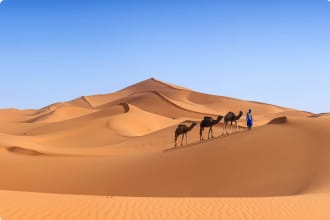
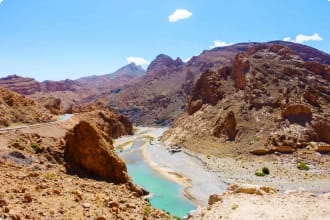
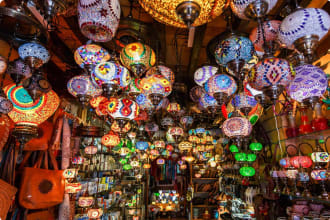
Itinerary
20 days
Day 1: Casablanca
Accommodation: New Hotel or similar
We make our way to the hotel individually. In the evening, we have a welcome meeting, followed by dinner at a local restaurant.
(D)
Day 2: Casablanca
Accommodation: New Hotel or similar
Following breakfast, we explore Casablanca, the business capital of Morocco. We start by visiting the French-inspired architecture of the Habous quarter, a unique example of how the French rebuilt a Moroccan medina while respecting the traditional style and habits. After lunch we will visit the great Hassan II Mosque, one of the largest mosques in the world (internal visit). Our tour also includes a visit to Anfa – the oldest part of Casablanca – followed by a stroll along the Ain Diab coast, which is dotted with swimming pools and restaurants. We finish the day with a group meal at our hotel.
(B, D)
Day 3: Rabat
Accommodation: La Tour Hassan or similar
In the morning we head off to Rabat, Morocco’s administrative capital. We visit the Mechouar Royal Palace: this is the primary and official residence of the King of Morocco. We visit the Oudaya Kasbah, a fortress built in the 12th century, and the mausoleum of Mohamed V, which contains the tombs of the king and his two sons. The building is considered a masterpiece of modern Alaouite dynasty architecture.
We then explore the Hassan Tower. Begun in the 12th century, the red sandstone tower forms part of an incomplete 12th century mosque. It was intended to be the world’s largest, but construction stopped with the death of Sultan Abu Yusuf Yaqub al-Mansur, of the Almohad Caliphate.
(B)
Day 4: Tangier
Accommodation: Marina bay or similar
Today, we make our way to Tangier. This major city is located on the Maghreb coast where the Mediterranean Seat meets the Atlantic Ocean. Its position at the western entrance of the Strait of Gibraltar places it right at the gateway between Europe and Africa. As such, it offers an incredibly unique blend of cultures.
On arrival at Tangier, the afternoon is set aside for your leisure.
(B)
Day 5: Tangier
Accommodation: Marina bay or similar
Today we experience a tour of this intriguing city, with visits to the Kasbah (medina) of Tangier and the Grand and Petit Soccos (bazaars). We view the Legation of the United States, which was the first American historical monument to be built outside of the States. We also visit St Andrews Church, which was consecrated in 1905 and exhibits a Moorish architectural style.
Finally, we make our way to the Caves of Hercules. This natural cave complex is located 14km west of Tangier. According to Greek mythology, this was the site Hercules went to rest after his exploits.
(B)
Day 6: Chefchaouen
Accommodation: Hotel Parador or similar
Today we drive to Chefchaouen, Morocco’s mysterious ‘Blue City’. This mountain village offers a sense of tranquillity and calm, and its distinctive blue-washed buildings are like an oasis in arid lands.
The reason for the colourful palette attracts a variety of theories. Some speculate the blue repels mosquitoes. Others say that this hue was introduced by the Jewish population who fled Hitler in the 1930s. Either way, many believe the blue symbolises the sky and heaven, and this may account for the spiritual experience that many travellers speak of.
The city was founded in 1471 to defend against Portuguese invasions of the north, and attracted many people who escaped the Reconquista of Spain. Don’t forget your camera as we wander the streets of Chefchaouen today!
(B, D)
Day 7: Chefchaouen - Volubilis - Meknes - Fez
Accommodation: Palais medina & spa or similar
Today, we take a scenic tour to Fez. Along the way, we stop in at the Roman ruins of Volubilis and sacred town of Moulay Idriss Ist. Next, we continue on to Meknes. This city was founded by Moulay Ismail at the end of the 17th century, and is known as the Moroccan Versailles.
While in Meknes, we will visit the Dar Jamai Museum, and Bab Mansour – the best preserved gate in Morocco. We check out the intricately designed horse stables of Moulay Ismail which, perhaps surprisingly, is among the region’s greatest ruins. Indeed, Ismail considered it his finest architectural achievement. It was built to accommodate 12,000 horses. Finally, we stop in at the Christian Prison, which is an eerie, underground space evocative of dark moments in history.
On arrival to Fez, we check in to our hotel and spend the remainder of the day at leisure.
(B, D)
Day 8: Fez
Accommodation: Palais medina & spa or similar
Ancient Fez is considered Morocco’s cultural and spiritual centre. One of the holiest cities in the Islamic world, Fez will take you back in time. We learn about the city’s history as a centre of government, philosophy, medicine and religion, while making our way through its most impressive landmarks and attractions. This includes the Jewish quarter, city ramparts, gates of the palace, and the Medersa Boulnania: this 14th century construction is considered a marvel of Marinid architecture.
We then take to the streets for a walking tour of Medina, a 9th century city that is home to one of the oldest universities in the world. We will visit the Borj Nord fort, and make the most of its’ panoramic views across the tombs of the Merinids. As we pass through old Medina, we will witness craftspeople practicing traditional techniques, including a ceramic workshop to end the day.
(B)
Day 9: Fez
Accommodation: Palais medina & spa or similar
Today, we will visit one of Fez‘s most iconic sights (and smells!). The Chaouwara tanneries offer a unique window into the production of world-class leather, using methods that have changed little since medieval times. In 2015-16, the facility did, however, undergo a restoration to spruce up the crumbling environs surrounding the pits. Lucky for us, this includes the viewing terraces, affording us great vision of this fascinating process.
The remainder of the day is set aside for your leisure. You may like to catch up on some rest, or venture further into charming Fez.
(B)
Day 10: Fez - Ifran - Midelt - Erfoud
Accommodation: Kasbah Hôtel Xaluca or similar
Today, we depart Fez for Erfoud. Along the way, we experience spectacular views of cedar forests, and visit the cute Barbary macaques at Ifran. We tour through the beautiful and scenic Midelt en route to the Sahara. And our passage through the Ziz Valley and Efous Oasis affords us incredible photo opportunities.
(B, L, D)
Day 11: Erfoud
Accommodation: Kasbah Hôtel Xaluca or similar
Our day begins at Erfoud’s fossil factory and museum, where fossilised rocks are fashioned into decorative objects. Then, we make our way to the Saharaoui town of Rissani. We stop here for lunch, and to experience the regional speciality of Medfouna. This savoury pastry can be compared to an Italian calzone.
After lunch, we board 4×4 vehicles and weave our way through various nomadic villages of the Sahara, before we arrive at the edge of the dunes. We traverse the stunning fine sands of Merzouga as the red sun falls toward the horizon.
(B, L, D)
Day 12: Ouarzazate
Accommodation: Hotel Ksar Ighnda or similar
Following breakfast, we depart for Ouarzazate, known locally as ‘the door to the dessert’. We travel through several landmarks, both human and geological, including the Todra and Dades Valleys, the thousand kasbahs road, and Kalaat Megouna – the “Town of Roses”.
We enjoy lunch en-route at Tinghir and dinner tonight is at our hotel.
(B, L, D)
Day 13: Ouarzazate
Accommodation: Hotel Ksar Ighnda or similar
Today, we explore Ouarzazate, including a stop at the Kasbahs of Tifelttout, whose atmospheric ruins emerge out of red sands.
Next, it’s onto the UNESCO World Heritage-listed site of the Ksar of Ait-Ben-Haddou: an impressive feat of Moroccan architecture. Here, earthen buildings crowd together within defensive walls, in the style of pre-Saharan construction and dwelling.
Later we explore the local souk with our guide.
(B, D)
Day 14: Marrakesh
Accommodation: Adam Park or similar
We journey from Ouarzazate to Marrakesh today. We drive along the Atlas Mountains following the Tizi n’ Tichka. This scenic route brings you through lush oasis valleys, and alongside imposing mountains.
Little by little, the red earth of the country rises up, contrasting with the clear blue sky and the eternal green palms. Finally, we arrive at Marrakesh.
(B) (D)
Day 15: Marrakesh
Accommodation: Adam Park or similar
Today, we explore Marrakesh in detail. This second oldest imperial city is known as the ‘Pearl of the South’. It boasts an impressive Jewish quarter and the Sidi bel Abbes Mosque – both of which we will visit. We also check out the Ben Youssef Madrasa, a 14th century Islamic college that now serves as a historic site. The Koutoubia Mosque is the largest in Marrakesh; we view this, along with the Bahia Palace.
Our day concludes at the world famous Djemma El Fna place, an exotic bazaar that promises varied and endless entertainments. Expect storytellers, snake charmers, fire-eaters, and more.
(B)
Day 16: Marrakesh
Accommodation: Adam Park or similar
This morning, we enjoy a tour of Majorelle Garden, one of the most visited sites in Morocco. The enchanting garden is the product of forty years of passion from French artist Jacques Majorelle. Majorelle was a noted Orientalist painter, but is best remembered for Les Jardins Majorelle.
In 1923, the artist bought a four acre plot of land on the border of a palm grove. He began planting and establishing a luxuriant garden before commissioning architect Paul Sinoir to design a Cubist villa within the grounds. Majorelle later painted this villa in a distinctive cobalt blue which soon became synonymous with the gardens. In fact, this colour earned the name “Majorelle blue”.
Majorelle continued to extend his garden, purchasing more land until it fell into disrepair for financial reasons. Mercifully, a second labour of love ensued, bestowed by renowned fashion designer Yves Saint Laurent and his partner Pierre Berge. They purchased the house and land during the 1980s and lovingly restored it. They also established the country’s first Berber Museum here, devoted to the history and culture of these indigenous people. When Saint Laurent died in 2008, his ashes were scattered here in these gardens. It is now the site of the newly established Musee Yves Saint Laurent Marrakesh, a museum that honours the designer’s contribution to haute couture.
We will wander among the reaching palms and exotic cacti of the gardens and visit the YSL foundation and museum.
Following this, the afternoon is set aside for your leisure.
(B)
Day 17: Marrakesh - Essaouira - Marrakesh
Accommodation: Adam Park or similar
Today, we enjoy a day-trip to the former Portuguese town of Essaouira, a magnificent harbour city situated on the Atlantic Coast. It is often compared to the Greek islands for its picturesque blue-shuttered houses. The city is also famed for its Gnaoua connection, referring to an ancient tradition of African spiritual songs and rhythms. Essaouira is the ensorcelante city of the musicians Gnaoua, and site of a music festival to honour this tradition in June each year.
But first, we drive to Ounagha to learn about the vast Argan tree plantations and meet the women who extract this sought-after ‘Moroccan oil’ using ancestral processes.
On arrival in Essaouira, we will be seduced by its historic ramparts which shelter sophisticated medieval architecture, a unique colour palette and a laid-back atmosphere that attracts artists and creatives. We enjoy a seafood lunch at a local restaurant.
In the afternoon, we enjoy a tour of Essaouira, taking in the great Moulay-Hassan square, the Grand Mosque, and Siaghine Alley. In the old town, we discover traditional Moorish art and cedar woodwork. We will learn about the city’s history here, as we weave through its maze-like streets and trace along its defensive walls.
We return to our accommodation in Marrakesh for the evening.
(B, L)
Day 18: Marrakesh
Accommodation: Adam Park or similar
Today we enjoy a full day of leisure – there are no scheduled activities. You might like to revisit some of your favourite sites so far, or use the day to discover more of Marrakesh‘s secrets. Alternatively, you may spend it relaxing and soaking up the atmosphere!
(B)
Day 19: Marrakesh
Accommodation: Adam Park or similar
This morning we visit the ruins of El Badi Palace. Its red pise walls and grand structure are enough to suggest its former glory: the palace was once nicknamed “The Incomparable”. It was commissioned by Saadian sultan Ahmed el Mansour in 1578. The funds for the project came from the ransom paid by Portuguese after the Battle of the Three Kings. The sunken gardens and 90 metre pool are still visible, and evoke a lingering sense of the luxury that once occupied this space.
As the Saadians fell and the Alaouite dynasty ascended, the palace entered a period of decline. Sultan Ismail Ibn Sharif systematically stripped the palace of its contents, material and decor to fund the construction of a new palace at his capital, Meknes.
Following Badi Palace, we visit the Saadian tombs. Al Mansour spared no expense here, either! He imported Italian Carrara marble and guilded the decorative, honeycomb shaped plasterwork with pure gold for the Chamber.
Two lavish mausoleums house around sixty tombs for members of the Saadi dynasty, with many more set in the surrounding gardens. All are overshadowed by the mausoleum of Al Mansour’s mother; its poetic carvings are guarded by stray cats.
Next, we check out Bab Agnaou, one of the nineteen gates of Marrakesh. Bab el Roor may have been the city’s official entrance, but Bab Agnaou gave entrance to the royal kasbah in the southern part of Marrakesh‘s medina. It was built in the 12th century during the Almohad dynasty.
Our afternoon is free for your leisure, but we reconvene for a farewell dinner.
(B, D)
Day 20: Marrakesh
Our tour concludes after breakfast.
(B)
Includes / Excludes
What’s included in our Tour
- 19 nights of accommodation.
- 19 breakfasts, 4 lunches, and 10 dinners.
- Services of Tour Leader for the duration of tour.
- Transport in comfortable and modern coaches or 4×4 vehicles
- All excursions, entrance fees, and local guides.
- Gratuities and necessary tips.
What’s not included in our Tour
- International airfares and departure taxes.
- Comprehensive travel insurance.
- Items of a personal nature such as telephone calls and laundry.
Participants must be able to carry their own luggage, climb and descend stairs, be in good health, mobile and able to participate in 3-5 hours of physical activity per day, the equivalent of walking / hiking up to 8 kilometers per day on uneven ground.
Book now
Make it a private tour
Easing your journey
Crossing international borders with restrictions
The list of requirements to travel internationally has changed and will continue to change for several years. Odyssey is here to assist you in managing your way through these requirements:
For more information see our Crossing international borders with restrictions page.
Book With Confidence
If less than 30 days before your tour starts you are unable to travel as a result of Government travel restrictions, Odyssey Traveller will assist you with a date change, provide you with a credit or process a refund for your booking less any non-recoverable costs.
See Terms and conditions for details.
Peace of Mind Travel
The safety of our travellers, tour leader, local guide and support staff has always been our top priority and with the new guidelines for public health and safety for keeping safe for destinations around the world, we’ve developed our plan to give you peace of mind when travelling with us.
See Peace of Mind Travel for details.
Reviews
I saw more and learned more about Morocco than I imagined I would. Really enjoyed that and the food was great including the camel tagine , steamed snails and pigeon pie. Wendy S. Apr '24
MY TOUR TO MOROCCO WAS WONDERFUL EXPERIENCE. TOUR CONTENT WAS THOROUGH AND EVERYTHING WAS WELL ORGANISED. WOULD TRAVEL AGAIN WITH ODYSSEY. Toni M. Apr '24
The Morocco tour was wonderful. A good itinerary, knowledgeable, and courteous guide, driver and leader, and a group of companionable, lively and good humoured travellers. Gorgeous all around. Nancy C. Apr '24
Morocco - a fascinating country full of contrasts. Full burkas and djellabas to skimpy shorts and tops. Snow laden trees in the Rif Mountains, to sand dunes in the Sahara. Desolate countryside and lush green valleys Beautiful boulevards as you come into a city with crowded old medinas. Busy cities and isolated villages with a few sheep or goats foraging on stony ground. Glorious buildings with breathtakingly beautiful decorations. Trees pruned into shape and mobile phone towers disguised as palm trees. Colours - from spices, fruit and vegetables in the markets to grey-green, red, red-brown, beige, and rose pink of the houses, rocks and countryside. With bright blue fishing boats and painted houses. Roman and Phoenician ruins and great modern engineering feats. A casual but obvious security presence. People patient with tourists as they go about their daily business. Morocco - historic, beautiful, a unique landscape, with a tolerant culture influenced by tradition and religion. Judith A. Oct '19
Reading List Download PDF
A Concise History of the Arabs
John McHugo
The key to understanding the Arab world - today and in the future - lies in unlocking its past. John McHugo unfolds centuries of political, social and intellectual development, from the Roman Empire right up to the present day. Taking the reader beyond the headlines, McHugo presents a series of turning points in Arab history: the mission of the Prophet Muhammad, the expansion of Islam, the conflicts of the medieval and modern ages, the struggles against foreign domination, the rise of Islamism, and the end of the rule of dictators. Accessible and penetrating, this concise history reveals how the Arab world has come to assume its present form and illuminates the choices that lie ahead in the wake of the Arab Spring. 'A lucid and highly readable history of the Arab peoples up to the present day. John McHugo has managed to show, with compassion, a good deal of humour and unerring historical judgment, the power of the ideas and the forces that have shaped what we now think of as the Arab world. In doing so, McHugo has provided a way of understanding this complex and ongoing story that will enlighten all who read it.' Charles Tripp, author of The Power and the People: Paths of Resistance in the Middle East
Lords Of The Atlas: Morocco And The Rise And Fall Of The House Of Glaoua
Gavin Maxwell
Maxwell is best known for Ring of Bright Water, the still selling account of his West Highland seaboard cottage and pet otters. He was also a distinguished travel writer on Iraq and Sicily. This posthumously published book (he died in 1968) is sub-titled The Rise and Fall of the House of Glaoua, 1893-1956, and is a history of Morocco's tribal dynasty which is informed by his own travels in North Africa. It's a fascinating slice of Moroccan history that is also a substantial chapter in the story of French colonialism. And, considering how far the writing of history has moved on since Maxwell's time, his own style seems remarkably fresh, readable and well-informed. The vividness of that writing is enhanced by lavish pictorial illustration, with 50 colour and 100 hundred black and white relevant photos, both contemporary and archival.
The Voices of Marrakesh
Elias Canetti
Nobel Prize-winning author Canetti spent only a few weeks in Marrakesh, but it was a visit that would remain with him for the rest of his life. In The Voices of Marrakesh, he captures the essence of that place: the crowds, the smells - of spices, camels and the souks - and, most importantly to Canetti, the sounds of the city, from the cries of the blind beggars and the children's call for alms to the unearthly silence on the still roofs above the hordes.
In these immaculately crafted essays, Canetti examines the emotions Marrakesh stirred within him and the people who affected him for ever.
Elias Canetti (1905-1994) is best known in the English-speaking world for Crowds and Power, Kafka's Other Trial and for the classic Auto-de-Fe. His family moved from Bulgaria to England, then Vienna, and he settled back in England in 1938. In 1981 he received the Nobel Prize for Literature. He was cited by the Swedish Academy for his 'writings marked by a broad outlook and wealth of ideas and artistic power'.
A House in Fez
Suzanna Clarke
When Suzanna Clarke and her husband bought a dilapidated house in the Moroccan town of Fez, their friends thought they were mad. Located in a maze of donkey-trod alleyways, the house - a traditional riad - was beautiful but in desperate need of repair. Walls were in danger of collapse, the plumbing non-existent. While neither Suzanna nor her husband spoke Arabic, and had only a smattering of French, they were determined to restore the building to its original splendour, using only traditional craftsmen and handmade materials. But they soon found that trying to do business in Fez was like being transported back several centuries in time and so began the remarkable experience that veered between frustration, hilarity and moments of pure exhilaration.
But restoring the riad was only part of their immersion in the rich and colourful life of this ancient city. A House in Fez is a journey into Moroccan culture, revealing its day-to-day rhythms, its customs and festivals; its history, Islam, and Sufi rituals; the lore of djinns and spirits; the vibrant life-filled market places and the irresistible Moroccan cuisine. And above all, into the lives of the people - warm, friendly, and hospitable.
Beautifully descriptive and infused with an extraordinary sense of place, this is a compelling account of one couple's adventures in ancient Morocco.
White Gold: The Extraordinary Story of Thomas Pellow and North Africa's One Million European Slaves
Giles Milton
This is the forgotten story of the million white Europeans, snatched from their homes and taken in chains to the great slave markets of North Africa to be sold to the highest bidder. Ignored by their own governments, and forced to endure the harshest of conditions, very few lived to tell the tale.
Using the firsthand testimony of a Cornish cabin boy named Thomas Pellow, Giles Milton vividly reconstructs a disturbing, little known chapter of history. Pellow was bought by the tyrannical sultan of Morocco who was constructing an imperial pleasure palace of enormous scale and grandeur, built entirely by Christian slave labour. As his personal slave, he would witness first-hand the barbaric splendour of the imperial court, as well as experience the daily terror of a cruel regime.
Gripping, immaculately researched, and brilliantly realised, WHITE GOLD reveals an explosive chapter of popular history, told with all the pace and verve of one of our finest historians
Marrakech Express
Peter Millar
Back in 1969 when Morocco's ancient capital was a hashish clouded happy mecca, Crosby, Stills and Nash recorded their cheesy (and hopelessly inaccurate) foot-tapping anthem 'Marrakech Express'. A generation on, award-winning journalist, author, and one-time glamrock fan Peter Millar uses what is now the country's best visited tourist destination as the embarkation point for a literally reverse-engineered train journey through this still exotic, diverse and challenging North African country, struggling to maintain its unique blend of tradition and tolerance in the turbulent winds of the Arab Spring.

